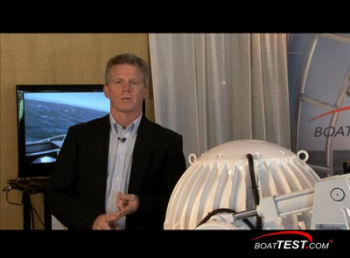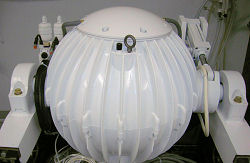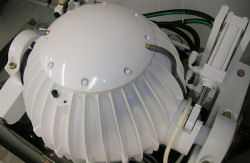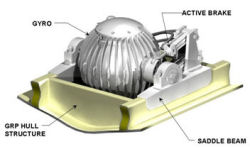The Seakeeper Anti-Roll Gyro System Is Picking Up Momentum Among Boat Builders
Even for people who rarely get mal de mer, constant rolling
on a long passage can be physically exhausting, because of the isometrics. involved
with holding on and bracing one’s self. For years the only solution to rolling were
hydraulically-actuated external stabilizing fins and flopper stoppers, those ungainly
booms and wires seen on trawler rigs. But we’re now in the 21st Century and Seakeeper
gyro-stabilizers have been installed on 18 different boat brands. Four major and
respected builders now have added Seakeeper to their official list of options: Azimut,
Fairline, Princess and Ocean Alexander. This is an important endorsement for a new
and revolutionary product. When buying a boat or retrofitting an old one, deciding
between stabilizing fins and a Seakeeper Anti-Roll Gyro can be a difficult decision.

|
| Captain Steve explains the advantages of Seakeeper's Anti-Roll Gyro system. |
See Capt.
Steve’s video on Seakeeper --
See Capt. Rob’s video on Seakeeper --
A boat rolls because its hull is doing what it is supposed to do – stay level with
water underneath it. But when the water under the hull changes angle, so too, must
the hull, thus the roll. The roll moment of most powerboats built today from 50’
to 150’ is from two to six seconds, with most boats being about four seconds. Large
round bottom boats may be more like eight seconds.
Conventional fin stabilizers jut from the bottom of a boat’s hull port and starboard
and are hydraulically actuated with power take-offs from the yacht’s marine gears
or engine. In order to be effective the boat needs to be moving at least 6 knots
or so with conventional stabilizing fins. New, “zero-speed” stabilizing fins work
even when the boat is at rest, but these systems are quite expensive.

|
Drawbacks to Fins
There have always been drawbacks to fins. Depending on the size of the fins, the
drag that they present can reduce a boat’s speed by as much as a knot. Except for
the very large and expensive “zero-speed fins” they do not work at slow speeds or
at rest. Zero-speed fins are not just expensive, they inlcude excessive noise, hull
through cutting, extra hydraulics and high power consumption. Because they
protrude from the hull they can become fouled or be sheered off in a grounding.
In speaking with owners who have made trans-ocean passages, one of the more common
equipment failures we hear about are the stabilizing fins.
Advantages of Seakeeper
The Seakeeper Anti-Roll gyro eliminates many of the drawbacks of conventional stabilizing
fins. Because they are completely internal, they do not introduce drag. That also
means they are not going to get fouled on lobster pot lines, kelp or other flotsam
and jetsam that might disable the fins. They can fit in any hull, no matter what
the shape. Because they use electricity instead of hydraulics, PTOs can be used
for other chores such as powering the anchor windlass and bow thrusters.

|
One of the strong attributes of the gyro system is that it can be used and is effective
when a boat is at anchor or even in marina. There is nothing more uncomfortable
than being an anchorage where the wind is coming from one direction and current
from another putting the boat broadside to the waves. A Seakeeper is an ideal solution
in this condition. Often being tied up at dock on the outside pier can be annoying
because of the constant passing of other vessels. Here the Seakeeper gyro can be
powered by shore power. Another Seakeeper advantage is that they do not require
hydraulics at all. Many of the smaller boats do have not have any hydraulic
systems to operate fins and since Seakeeper only use electricity, the installation
become much more simple.

|
Roll Attenuation of 60% to 80%
Tests made by BoatTEST.com as well as a number of boat builders have found the Seakeeper
Anti-Roll units to be at least as effective as conventional fin stabilizers. John
Kermet of Seakeeper, says that the company’s products attenuate roll from 60% to
80%, in most cases.
On tests last year on a Viking 43 convertible, roll reduction of 80% was recorded,
Kermet told us. One gyro was used on that boat. Boats up to about 60,000 lbs need
only one gyro, but boats heavier and bigger need two or even three of the units
to be sufficiently effective. We’re told that Seakeeper is working on a new and
far larger unit so that one gyro can handle larger boats.

|
What are the drawbacks to anti-roll gyros? Essentially, there seem to be two. First,
they seem expensive. The Seakeeper gyro installed is really no more expensive
than a zero-speed fin system installed. Furthermore, the overall cost of ownership
due to mantenance is much lower for the gyro as it is fully protected inside the
hull of the boat. Second, they take up room, something that is always in short
supply on a boat. We have seen them installed in a lazzerette and in engine rooms
and the units are about the size of a 20kw generator. Boat brands in which Seakeepers
have been installed are Azimut, Ferretti, Pershing, Carver, Marquis, Sunseeker,
Marlow, Fairline, Sea Ray, Princess, Terranova, Zeelander, Ovation, Couach, MGBW,
Ocean Alexander, Maritimo, Viking.
For more information, visit
Seakeeper…